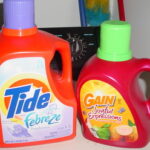Working with middle school children on their science fair projects can be a lot of fun. When a 6th grader creates a science fair project there are several things that go along with the experiment itself. They will need a written report, a visual display, and an oral presentation with their project. Following is a list of projects that are fun and easy for an 6th grader.
1. Do Expensive Laundry detergents Clean Better?- This is a simple, fun and helpful 6th grade science fair project. Your basic idea for the project is to see if more expensive detergents will clean better than the cheaper detergents. You will need the following items for this project:
1. Laundry detergent (of different price ranges)
2. Loads of laundry
3. Notebook
4. Pencil
5. Camera
What you need to do is wash as many loads of laundry using different detergents. Begin by taking several plain shirts that are similar and adding stains to them. You want it to be the same stains so that you can see which one will get them out better. It may be best to use dirt and smear into the clothes. Make sure that you get parents permission first. Then as you use different laundry detergents make sure to take notes of the results. You should also take before and after pictures for each detergent so that you can show the results. These pictures can be posted on your display board, so that they can see how you reached your final results.
2. How to remove oil from water- This science project for 6th graders is a lot of fun and will help kids to learn how you can remove dangerous oil from water. This is a great environmental project that will help kids to understand how difficult it is to clean up after a disastrous oil spill. You will need the following items:
1. Three plastic containers
2. Several cans of motor oil
3. Spoon
4. Sand
5. Cheesecloth
6. Black Marker
7. Index Cards
8. Notebook
9. Pencil
The first thing you will need to do is fill all three containers with water. Put sand in one of the containers. Use the index cards to label the containers with letters. For example the first container could be labeled A, second B, ect. Tape each index card to the containers. This will help when you are ready to identify your results. Now you can pour the motor oil into each of the containers. Then you can try using the spoon in one of the containers to see if this is an effective way to remove the oil. Next you can do the same thing with the cheesecloth. You can then see if it is possible to scoop the oil out of the container with the sand. You can try several different various and methods to see what would be an effective way to remove the oil. Make sure to take plenty of pictures so that you can have it on display. With this project I feel it is best to use your imagination and be as creative as possible.
3. How plants grow without soil- This science project for 6th graders is really simple to do and will help the student learn all about hydroponics. They will learn how to supply nutrients through the water supplied to the plants. You will need the following items of this project:
1. 3 small plants
2. 3 containers
3. Cup
4. Index Cards
5. Black Marker
6. Hydroponics nutrients (dry or liquid, can be found as local gardening center)
7. Notebook
8. Pencil
9. Camera
If you have purchased potted plants you can very easily remove these from the dirt. When doing this make sure not to damage the roots. The roots need to be in tact in order to take in the water and the nutrients. Once you have uprooted and your plant’s place them each in their own container. Fill each container halfway with water. Now label your container with different letters, so that you can keep track in your journal. Make sure to take pictures now so that you will have before and after pictures. Now you will need to add the nutrients to the water. The hydroponics nutrients that you purchase should have directions on how much to add to the water and how often. When working on this project myself I found that it is best to document everything so that you can use it in your report later. This way as your plant begins to grow you can show the progress it has made. This project obviously takes several days to complete but I have found it teaches children that they need to have patience. They learn that not every answer is instantaneous. This is really a great lesson for children to learn, and you will be surprised at how well any 6th grader can do with this type of project. Make sure that you document and maintain the nutrient levels through out each day. You will be amazed to see that roots begin to grow. It really is a fun process to watch.
4. How to use plants to cool a home– This science project for six graders is a fun way for children to learn about how they can use the environment to benefit everyday life. You will need the following items for this project:
1. 2 small cardboard boxes
2. 3 medium size plants
3. Outdoor thermometers (to measure air temperature)
4. 1 can of black paint
5. 1 can of white paint
6. Notebook
7. Pencil
8. Camera
This experiment will take several days to complete and has several different stages. Before you begin it would be nice to decorate your boxes to actually look like houses. The first thing you need to is take the boxes (which are going to be your houses) and place them outside in the sun. It would be best to place them side by side to make sure they are getting the same amount of sun. Place one thermometer inside each of the boxes. Leave the thermometer in the box for at least 5 minutes than record the temperature in each box (they should be the same). Now take one of the plants and place it in front of the box so that it cast a showdown over the box. You want the entire box to be covered by the shadow. Then place the thermometer back in the box. This would be a good time to take the first picture for your visual display board that you will make later. Leave the plants like this for at least two hours and come back and record the temperature in ach box. Make note of any differences you find.
Once you have that information you can then move on to painting your boxes. One should be painted white and the other black. Then place both of the boxes back in the sun, with the thermometers inside. Leave in the sun for about an hour and come back to record the temperature in each box. With this project I have found that students get better data to compare when they check the temperature every hour for about three hours. What you want to see here is if the temperature changes in the box because of the lighter and darker colors.
Finally you will want to take both boxes after being painted and use the plant to block the sun. They should be completely shaded. Then record the temperature over the course of about three hours to see if there are any changes. The main objective of this project is for students to see if it is possibly to keep your house cooler by have more trees to shade your home, and to see if the inside temperature would be affected by the color of the home. Make sure you take plenty of pictures each time you check the temperature so that you can use this as a visual display in addition to your boxes. I have seen many students win prizes with this particular projects.
5. How does Hydro Power work– This science project for sixth graders is a great way for students to see how energy is harnessed form water. You will need the following materials:
1. Piece of cardboard
2. Scissors
3 . Box of Pins
4. Cork
5. Notebook
6. Pencil
7. Plastic Container
8. Cup
9. Camera
The first thing that you do is cut a long piece e of cardboard in a rectangular shape. Then fold it into threes. Now you can tape small rectangular pieces of cardboard onto the cork. It should look very similar to a water wheel. Next take the cork and the pins and pin the cork in between the two end pieces of cardboard. At this point you should take a few pictures that can be displayed while giving your oral report. Now place the entire wheel into the container. Use the cup to pour water over the cork to make it turn. You will need to replace the pieces of cardboard after several uses when it becomes drenched, but you should be able to get several good spins at first. I have seen children easily demonstrate this in school.




